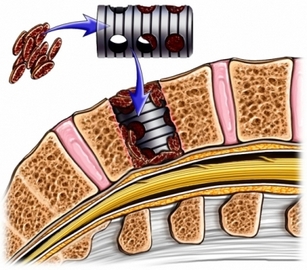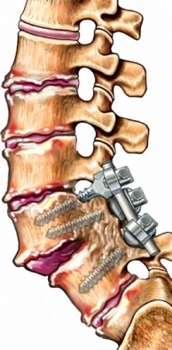Vertebral Arthrodesis – Spondylosyndesis
Spine fusion description
Spondylosyndesis – operation via two vertebrae. The vertebrae are called bones, consisting backbone.
Causes execution of the surgical
Vertebral Arthrodesis is applicable for the treatment of persistent pain and injuries as a result of the following disorders:
- Stenosis (narrowing of the spinal canal);
- Damage to the spine;
- Spondylolisthesis (size of vertebrae differs from normal);
- Scoliosis (abnormal curvature of the spine);
- Weak or weakened spine, usually, as a result of infection or tumors;
- Herniated disk.
Spondilodez can be held, If you previously used treatments are not eased pain and spine condition. Therapies, applied before surgery spine fusion:
- Recreation;
- Painkillers;
- Muscle relaxants;
- Physiotherapy;
- Injections of drugs to relieve pain and swelling;
- Massage;
- Mount;
- Behavioral (behavioural) therapy.
Pictures of the spine will determine, can I fix the problem by using the artrodeza vertebrae.
Possible complications artrodeza vertebrae
Complications are rare, but no procedure does not guarantee the absence of risk. Before, How to perform the fusion of vertebrae, you need to know about possible complications, which may include:
- Bleeding;
- Infection;
- Incomplete healing of bones;
- Blood clots;
- Hematoma (the accumulation of blood in the wound);
- Nerve Damage, causing pain, numbness, a tingling sensation or paralysis;
- Violation of bowel function and/or bladder.
- Reaction to anesthesia.
Factors, that may increase the risk of complications:
- Smoking;
- Poor diet;
- Obesity;
- Advanced age;
- Pre-existing diseases.
How does interbody fusion of the vertebrae?
Preparation for the procedure
Before surgery, your doctor can be assigned the following:
- Medical checkup, especially back and neck;
- Roentgen – test, which uses X-rays to take pictures of structures inside the body;
- Magnetic resonance imaging – test, which uses magnetic waves, to make pictures of spinal nerves and disks between the vertebrae;
- Myelogram – such as X-rays, that uses x-ray dye, that is injected around the spinal cord and helps identify areas of pressure on the spinal cord or nerves;
- Sometimes used CT scan, such as X-rays, which uses computer, to make pictures of the bones of the spine.
In the run-up to the artrodeza vertebrae:
- Tell your doctor about taking any medications. A week before surgery, perhaps, you need to stop taking certain drugs:
- Aspirin or other anti-inflammatory drugs;
- Blood thinners, such as clopidogrel (Plaviks) or warfarin;
- Need to arrange a trip home after surgery and home care in recovery period;
- On the eve of the evening before surgery you can eat a light meal. Do not eat or drink anything the night.
Anesthesia
When the cervical artrodesis vertebrae is applied general anesthesia, which blocks the pain and the patient support in a sleep state during operation. Also used spinalynaya anesthesia, which Painkiller operated part of the body.
Describes how spine fusion
The doctor makes an incision in the back or neck. The muscles will be extended, to access the spine. The doctor can connect bones or:
- Set transplants, made from pieces of bone or bone material (pieces of bone can be taken from the pelvis or hips);
- Install small metal sleeve, filled with bone graft material (liner can be placed between the vertebrae).
The doctor uses the screws and plate or studs for fixation of bone, until they grow together. The incision will be closed with sutures or Staples.

How long will it take to spondilodez?
4-6 hours (sometimes more).
Spondylosyndesis – Will it hurt?
Anesthesia will prevent pain during surgery. After the surgery, the doctor will prescribe pain medication, to prevent the pain.
The average time of stay in the hospital after spine fusion
3-4 day (sometimes less, sometimes more depending on age, General health and extent of surgery).
Care after spine fusion
Care in a hospital
In the hospital, you can receive the following assistance:
- Painkillers;
- A bandage may be imposed or a retainer;
- Training, How to properly move, sit, standing and walking;
- Training, How to go to bed without twisting the spine;
- Assigned physical therapy;
- You need to wear special socks or shoes, to prevent blood clots;
- When you are in bed, you need to periodically move your feet. You will also be asked to get up and walk around several times a day.
Home Care
After returning home, follow these steps:, to ensure the normal recovery:
- Be sure to follow your doctor's instructions;
- Keep the incision site clean and dry;
- Ask the doctor, when it is safe to shower, bathe or expose the surgical site to water;
- When you are in bed, move your feet. This should improve blood circulation and reduce the risk of blood clots;
- Do not lift anything heavy;
- Bone and grafts grow together in a few months. At this time you need to restrict physical activity;
- Before taking the new drugs should consult with a physician;
- Seams or brackets are removed within two weeks;
- Your doctor may recommend avoiding heavy and strenuous activity, which is linked to lifting heavy objects and twist the spine.
Rehabilitation after spine fusion
Rehabilitation may be performed in a hospital or in a clinic. Program, probably, will include:
- Exercises to strengthen your back;
- Exercises with a low load on the spine, such, like walking or swimming.
Recovery time ranges from 4-6 weeks before 4-6 months. It will depend on the age, General health and physical form.
Complete healing of the bone may take up to a year after surgery. You, probably, Notice the reduced flexibility of the spine, in the place where the bones have grown together. The rehabilitation program is designed to speed recovery and reduce the discomfort.

Communication with a physician after spine fusion
After discharge from the hospital need to see a doctor, If the following symptoms:
- Signs of infection, including fever and chills;
- Redness, edema, strong pain, bleeding or discharge from the incision;
- Nausea and / or vomiting, that do not pass after taking the prescribed medicines and persist for more than two days after discharge from the hospital;
- Pain, which does not pass after taking pain medication appointed;
- Cough, shortness of breath or chest pain;
- Joint pain, fatigue, constraint, rash or other symptoms;
- Numbness, pricking, pain or weakness, especially in the hands or feet;
- Pain, swelling in the legs, feet, or the shins;
- Urinary bladder or intestine;
- Pain, burning, frequent urination or persistent blood in the urine.
